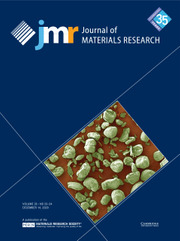Article contents
Model of chemical vapor infiltration using temperature gradients
Published online by Cambridge University Press: 31 January 2011
Abstract
An optimized chemical vapor infiltration (CVI) process has conditions that promote complete densification at the fastest allowable reaction rate. In order to help define optimum conditions, a model has been developed to simulate the CVI of a fibrous specimen for determining the effects of temperature gradients along with the other processing parameters such as pressure, size, chemistry, rate of reaction, and porosity on the resulting deposition profiles. This model simulates the deposition of alumina matrix within fibers wrapped around a tube. This symmetry reduces the model to a simple one-dimensional problem. Parameters for transport properties, calculated using a local microstructure model, are used in this macroscopic model. The model is applied as a guideline for choosing optimum conditions for producing a dense ceramic matrix composite. From this model, process diagrams are constructed that can help an experimentalist to choose the best conditions for the CVI process using temperature gradients.
- Type
- Articles
- Information
- Copyright
- Copyright © Materials Research Society 1997
References
- 11
- Cited by


